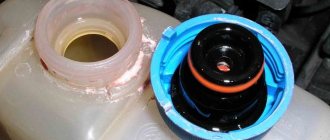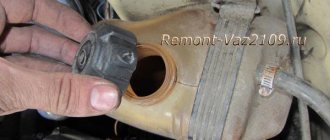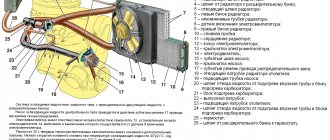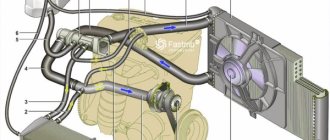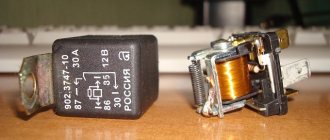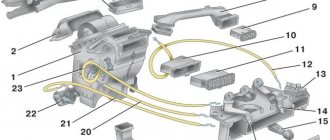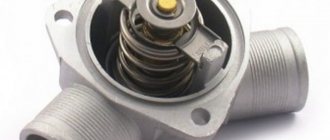A car engine, like any internal combustion engine, heats up during operation, so it needs to be constantly cooled. Cooling systems are designed for this purpose. According to the principle of operation, they are of two types: liquid and air. The first ones are most widespread, although they are more complex structurally. “Air vents”, despite their simplicity, are much more prone to overheating.
Since all engines today operate with liquid cooling, in the engine compartment of any car there is a small container made of translucent plastic with a lid, designed for pouring antifreeze. This is the expansion tank of the engine cooling system. For different engines, the volume of the expansion tank ranges from 1.5 to 8 liters.
His purpose
What is the expansion unit used for? The fact is that any liquid increases in volume when heated. Thus, the volume of water when heated to 100°C increases by 4.5%, antifreeze and antifreeze - by up to 6%. To prevent the coolant from pouring out of the system when it is heated, an expansion tank is needed, which is a kind of buffer or compensator.
Until the middle of the last century, there were no expansion tanks under the hood, since ordinary water was used as coolant, and the role of a compensator was played by the upper radiator tank, which was not topped up “to capacity.” With the advent of ethylene glycol-based coolants (antifreeze), the coefficient of volumetric expansion of which is greater than that of water, additional expansion tanks appear so as not to enlarge the radiator.
Thus, the expansion tank (EB) is designed to compensate for the volumetric expansion of the coolant as its temperature increases. The RB is located in the engine compartment so that the fluid level is approximately at the middle of the height of the tank.
In this case, the liquid in the radiator and tank is located at the same level according to the principle of communicating vessels. Since the RB is located above the radiator, the expansion tank cap is used as a filler neck, which will be discussed below.
The antifreeze tank is leaking: troubleshooting and solutions
The situation when the antifreeze reservoir leaks is not that uncommon, especially on used cars. Of course, the easiest way out is to replace the expansion tank and move on. However, it happens that the reason was not in him (or not only in him), and the money will be wasted.
Another equally important question is how long can you operate a car that has problems with the cooling system. The article below describes the design of the cooling system and talks about why the reservoir may leak. And there is a story about actions in such a situation.
Car cooling system design
After the engine starts, the temperature in the cylinder block increases, significantly exceeding the maximum permissible values. To prevent the engine from overheating, it is necessary to ensure constant heat removal from the rubbing elements. This function is performed by the internal combustion engine cooling system.
To maintain optimal temperature, the following mechanisms and parts are located in the engine compartment:
- expansion tank;
- radiator (with filler neck and drain valve);
- thermostat;
- several connecting pipes;
- faucet on the cooling jacket;
- water pump;
- water pump drive belt;
- radiator for interior heating system;
- emergency engine temperature control sensor.
If one of the above elements fails, the motor will begin to overheat. This can happen because the radiator is clogged, scale has appeared, the tension of the water pump drive belt is insufficient, or the thermostat valve has become stuck.
Signs that antifreeze is running out
When the temperature indicator lights up, signaling that the internal combustion engine is overheating, this indicates an antifreeze leak from the expansion tank. As a result, heat is not removed from the rubbing elements of the engine.
But an increase in engine temperature can also occur for other reasons. For example, because the water pump has broken down or air has entered the cooling system. To find out if the antifreeze reservoir is leaking, carefully inspect the car, perhaps:
- antifreeze leaks formed under the car;
- there is a low level of coolant in the expansion tank;
- oily puddles appeared on the floor in the car;
- exhaust color is white;
- the car's heater is not functioning well;
- the engine overheats regularly;
- steam comes from under the expansion tank cap;
- There is a specific smell of coolant in the cabin.
6 reasons why the antifreeze tank is leaking
If you drive your car frequently, the cooling system may fail. Antifreeze leakage from the expansion tank can occur for various reasons. Next, we will consider the most common of them, so that you can independently determine why the breakdown occurred and fix the problem. Remember that you should not put off repair work.
1. Burnt out cylinder head gaskets.
Most often, antifreeze leaks from under the tank for this very reason. The cylinder head gasket burns out because the engine overheats. How to understand that a malfunction occurred due to depressurization of the system? To do this, follow the following algorithm of actions:
- start the engine, open the tank lid;
- If the internal combustion engine is idling and you observe air bubbles from the main hose, it means the gasket has worn out.
How does a breakdown of the seal manifest itself:
- if the gasket is damaged from the inside, the color of the exhaust gases will be white;
- when the outer part of the seal is worn out, you will notice antifreeze leaking from under the reservoir, and the smudges will fall on the cylinder block.
Damage to the outer part of the gasket occurs infrequently. In most cases, it wears out from the inside, allowing coolant to seep into the cylinder.
If you do not immediately replace the damaged seal, you may encounter the following problems: the internal combustion engine will jam, a water hammer will occur in the cylinder head, and cracks will form in the engine housing.
2. The cooling system has become airy.
If you have changed the antifreeze or the system has become depressurized, an air lock appears, preventing the movement of coolant. As a result, the stove will not function normally, the internal combustion engine will overheat, and you will notice that the antifreeze reservoir is leaking.
How can you understand that the reason for all of the above is the formation of an air lock? To do this, it is necessary to perform a “gas adjustment”: the engine must run at high speeds. Have you noticed that bubbles have formed in the expansion tank and the antifreeze level has decreased? This means you managed to break the air bubble.
3. The expansion tank has failed.
It also happens that the antifreeze reservoir itself leaks, in which case smudges form on it and under it. When the expansion tank is located between the body elements and a crack appears in its lower part, it is necessary to remove the tank and inspect it. Why does the coolant squeeze out:
- The expansion tank cover is not closed tightly. When the internal combustion engine is running, an antifreeze leak forms;
- the bypass valve, which is located in the plug, is not functioning correctly;
- The expansion tank is made of low quality material, so it cracked.
The tank is made in such a way that there is a built-in safety valve in the plug. It relieves the increased pressure generated when the coolant heats up. When the valve stops functioning normally, due to the increase in pressure, antifreeze leaks through the joints of the pipes or the threads of the plug.
For clarity, let’s look at an example: on a VAZ 2110 car, if the valve malfunctions, the expansion tank ruptures. In such a situation, you will immediately determine that the antifreeze reservoir is leaking, as coolant will pour out through the crack. At the same time, steam will come out from the engine compartment.
4. The pipes are out of order.
Over time, rubber loses its original characteristics. Therefore, the pipes crack and need to be replaced. In this case, you will notice a coolant leak when the engine is warm, as the pressure in the system will increase. To understand which pipe has failed, carefully inspect all the hoses. Feel the areas where the pipes connect to the radiator fittings and the cylinder head.
It was not possible to determine which pipe has failed, but do you smell coolant in the cabin and under the hood? This means that the antifreeze reservoir is leaking, and the liquid enters the exhaust system and then evaporates.
5. Antifreeze leak.
It often happens that due to a low level of coolant in the system, antifreeze is released into the expansion tank. As a result, the liquid heats up too quickly, causing the internal combustion engine to overheat. As a result, the antifreeze evaporates and the pressure in the system increases. The coolant is continuously distilled into the expansion tank, no matter what mode the internal combustion engine is operating in.
Have you noticed that even when the engine has cooled down, the coolant level has not changed? This means that the circulation is not happening correctly. If the antifreeze level drops below the minimum value, the system is most likely depressurized. You should find out why this happened and carry out repair work.
6. The radiator is faulty.
An antifreeze leak from under the tank can occur due to a failure of the radiator. Why does this crash occur:
- the honeycombs were damaged, for example, after being hit by a stone while the car was moving;
- rust has formed on the radiator;
- The side plastic radiator tanks failed after long-term use.
To understand that the antifreeze reservoir is leaking, you do not need to dismantle any components. You will notice a leak immediately, especially when the tanks are damaged.
Actions with a leaky tank
A leak can form for various reasons. Most often this happens because the system has become depressurized and the antifreeze evaporates from the expansion tank. When the reservoir is cracked, you will notice stains of coolant on it.
Do you suspect that the antifreeze reservoir is leaking? You should inspect the container; it may have mechanical damage. It is not possible to repair the tank on your own; it is recommended to replace it.
When the expansion tank, as well as the cap and gasket, have not been changed for a long period, cracks form on them. Liquid can also escape through the safety valve on the reservoir cap. To fix the leak, you will need a new cap and gasket. You can also install a new expansion tank.
In some cases, repairing the tank is allowed. This element is made of a material that does not react with adhesives, so it is impossible to glue a cracked container. How to properly restore the expansion tank? The following methods are used for this:
- soldering a crack on the body using a metal mesh;
- use of epoxy resin, cold welding or sealant.
The container cracks because it is continuously exposed to pressure and elevated temperature. Using cold welding and epoxy resin will only delay the replacement and repair of the tank.
Many car owners are interested in how to fix cracks in a plastic expansion tank? If you want to carry out repair work yourself, proceed as follows:
- clean the tank in the area where it is cracked with a clean cloth;
- apply a degreaser, wait until the surface dries;
- prepare a piece of brass mesh with small cells;
- apply a strip to the crack;
- Using a soldering iron, we fix the mesh to the edges of the crack so that we get a reinforced layer over the entire area of the mesh;
- sand the seam;
- Cover with putty, then prime and paint.
The easiest way to repair a cracked container is to use a fine metal mesh.
Restoration can only be done if you have a 40 W flat tip soldering iron. You can also use red Done Deal sealant, it is suitable for plastic surfaces. Before applying it to the tank, clean the cracked area and degrease it.
What do car enthusiasts do if the antifreeze tank is leaking?
- Why is the antifreeze reservoir leaking ? “I encountered such a problem, I had to add antifreeze. There were no leaks on the hoses, the plug was also dry. I dismantled the tank and carefully examined it - the container was all covered in cracks. Why did the leak form? Due to the heating of the coolant, the pressure increased, the cracks expanded and antifreeze leaked out. The spar was covered in coolant.”
- The expansion tank is in perfect condition. “I noticed a leak from under the lower thick hose. I didn't use sealant. I cleaned the necks of the pipes from any irregularities, put the hoses on the “warm” one, and tightened them with clamps. It is important that they lie perpendicular and do not put pressure on the thickening at the end of the fittings. I would never have thought that on a warm engine, antifreeze would leak out through small irregularities in the fitting or if the clamp was not installed correctly.”
- The cause of the leak is the tank cap. “We install the end of the pump hose onto the fitting of the expansion tank, fix it with a clamp, clamp the other fittings with our hands, and press on the pump with our feet. When the air pressure is sufficient, the valve in the tank lid will open: the pressure will be released. I checked different caps several times, the valve operated with different pressures. Once the valve operated at high pressure, the tank almost burst. I don’t recommend installing such covers, because the expansion tank will crack.”
- Repairs cannot be delayed.
“On my car it was like this: the antifreeze reservoir didn’t seem to be leaking, but 60 g of fluid per week was definitely lost. I noticed that the lid was wet. Yesterday, antifreeze got into the combustion chamber and white smoke came out of the exhaust. The engine began to stall, five liters of coolant evaporated within 3 hours of driving.” - We restore it with our own hands. “I bought epoxy resin, the fabric is not fiberglass, but PVC or PVC. The material dissolves in acetone and hardens when hardened. Previously, house tiles were laid on it. First I dissolved the fabric and tried to glue it. But she fell off. After that, I diluted epoxy resin, applied it to fabric and stuck it to the tank. After 3 months, the patch turned red from the coolant, but the antifreeze reservoir does not leak.”
If you find an error, please select a piece of text and press Ctrl+Enter .
Share
Design and operation
The expansion tank consists of a polypropylene body, a cover and two pipes for connecting hoses of the liquid system. Using the lower hose, the device is connected to the cooling line, the upper one serves to remove vapors and air bubbles from the system. On modern models, float coolant level sensors are often installed.
For this option, the expansion tank is equipped with another neck on top, intended for installing a sensor. Several control marks are applied on the side surface of the container, from the bottom - min to the top - max. The coolant level should be located in this interval.
How does the device work? First, a little theory. The table shows the operating temperature conditions of modern engines. As we can see, the engines operate in critical temperature conditions.
| Engine temperature, °C | Working | Short term |
| 80 — 100 | 120 — 125 | |
| Boiling point of liquids, °C (at atmospheric pressure) | water | 100 |
| antifreeze | 105 — 110 | |
| antifreeze | 120 |
To raise the bar for permissible temperature, designers increase the pressure in the coolant (more than atmospheric), due to which its boiling point increases. To do this, the system is closed hermetically and excess pressure is maintained in it. For different engines, this value ranges from 0.1 to 0.5 bar (kg/cm²).
At the same time, significant vacuum (more than 0.03 - 0.1 kg/cm²) in the free space of the expander is unacceptable, since air will be sucked into the system, which will lead to the appearance of air pockets that impede coolant circulation and, consequently, to engine overheating . Maintaining the coolant pressure at the required level is the responsibility of a special regulator located in the filler cap.
Possible problems
Proper surface cleaning is the key to successful repairs. After a long period of use, the coolant in the reservoir is difficult to wash out. Motorists often use special cleaners, washing powder or citric acid solution.
In case of extensive contamination, the expansion tank is cleaned with fine gravel. The container is filled 15% with the dry ingredient, then filled with warm liquid and dishwashing detergent. The tank is gently shaken, trying to hit all the walls. The components are drained and the interior is washed with plenty of moisture.
Possible errors during repair Source drive2.com
“Atas Dimer” helps with traces of antifreeze. Concentrated alkaline substance copes with tough dirt. To operate, 15% of the liquid introduced into the container is sufficient. The expansion tank is shaken and left to work for 10 minutes. After time, the structure is filled 50% with warm water. The walls are cleaned with a long-handled brush. After the procedure, rinse thoroughly.
After gluing, the remaining fixing agent must be removed. The fresh mass is removed as it is released with a cloth. If the seam has already polymerized, then the defects will have to be cut off with a knife. Irregularities are smoothed out with fine sandpaper.
Tank cover - two in one
So, the RB cover, in addition to its protective function, also performs the task of a pressure regulator. As stated above, the pressure inside the tank should be up to 1.1 - 1.5 kg/cm². How is this achieved?
For this purpose, two valves are mounted in the lid: safety and vacuum. The first is a spring-loaded rubber diaphragm that is pressed from the outside and releases when the pressure exceeds the force of the spring. The second consists of a rubber washer with a small spring installed inside a large one.
At operating coolant temperature, both valves are closed, the pressure in the tank does not exceed the design pressure. Since the expansion tank is hermetically sealed, the pressure increases as the temperature rises, causing the safety valve to open and release some of the air vapor, returning the valve to its previous position.
The absence of a safety mechanism would lead to coolant leaks, damaged connections, and even rupture of the cooling radiators and heater.
After stopping the engine, the liquid in the system cools and decreases in volume, which leads to a vacuum inside the tank. The result may be air leaking through the connections, which will lead to the formation of air bubbles during subsequent startup. And this can lead to overheating and engine failure.
This is where another small valve comes to the rescue - a vacuum valve. Under the influence of vacuum, it opens and equalizes the pressure in the tank with atmospheric pressure.
Questions regarding the correct selection and replacement of the expansion tank
During vehicle operation, the expansion tank is exposed to high temperatures, significant pressure drops and aggressive environments (antifreeze, exhaust gases, fuel, oils, etc.) - all this can lead to damage to the tank and filler plug. The most common problems with plastic tanks are cracks in the body and ruptures due to excessive pressure build-up. In any of these cases, the tank must be replaced, and repairs must be made as soon as possible.
For replacement, you should only take a tank of the same type and catalog number that was installed on the car by the manufacturer - this is the only way to guarantee the correct operation of the entire system. If the plug also fails (which is usually indicated by a tank rupture due to a malfunction of the steam valve), then you need to buy that too. If the old plug works normally, then it can be installed on the new tank. The old liquid level indicator, as a rule, is also installed on the new tank without any problems.
Replacing the expansion tank must be carried out in accordance with the vehicle repair instructions. Usually, to perform this operation, you need to drain the antifreeze, disconnect all the hoses from the old tank, dismantle the tank (it is held in place by a clamp, sometimes with additional screws) and install the new part in the reverse order. In this case, it may be necessary to replace old clamps, so you should immediately take care of purchasing them. And if an old plug is installed, then it needs to be checked and, if necessary, cleaned.
After installation, it is necessary to fill in new antifreeze and close the plug; if you correctly select, replace and connect the new tank, the entire system will immediately begin to work normally, ensuring effective cooling of the power unit.
Source
RB malfunctions and causes
Decrease in coolant level:
- leakage of the plastic body of the tank due to aging of the material, in particular, this was a chronic disease of the tanks of VAZ cars;
- The safety valve does not work, as a result of which increased pressure squeezes antifreeze through the joints.
Engine overheating:
- due to decreased volume of liquid due to leaks;
- The vacuum valve does not work, resulting in air appearing in the liquid (“airing”).
Visible fluid leaks:
- expansion tank is leaking;
- safety valve malfunction.
Replacing the expansion tank with your own hands
Anyone can change the expansion tank on any car.
The procedure for performing the work is approximately the same for all brands and models:
Drain the liquid from the tank and pipes.
You need to place a container under the drainage area in advance so that antifreeze or antifreeze does not fall on the floor or ground. Do not forget that this liquid contains methyl alcohol, so the drainage area can be considered a fire hazard.
Disconnect the fastenings from the tank (usually they are made in the form of ties or clamps).
Remove the pipes from the tank.
Install a new expansion tank, connect the supply hoses to it, and secure them with new clamps for reliability.
Fill with new antifreeze/antifreeze.
Make sure that there are no leaks at the joints of the tank and pipes, and also that the same amount of liquid was filled in as was drained.
Video: the process of replacing the tank on VAZ cars
Thus, the driver can solve any problems with the expansion tank independently.
This product is not at all expensive, so in most cases, car enthusiasts prefer to buy new tanks rather than repair old ones.
Source
Checking the functionality of the lid
Simplified test: are the valves working?
We start the engine and, being careful, unscrew the cap: if you hear the hissing sound of a deflated chamber, the bypass valve is working (however, whether it is correct or not is unknown).
After removing the cover, squeeze any hose of the cooling system with your hand. Continuing to hold it in this way, put the cover in place. If it then regains its shape, the vacuum appears to have been filled. But if, even before starting the engine, the hoses look like they are flattened, the vacuum valve is definitely not working.
More accurately, the safety valve can be checked using a pump and pressure gauge. We connect the pump to the lower supply pipe of the tank, and plug the upper one using improvised means: a bolt or a cylindrical drill that fits tightly into the supply hose.
We create pressure with the pump and control the moment when the safety valve is activated (hissing sound). The pressure value recorded on the device scale shows the actual response pressure.
If the safety valve is too tight, it can be repaired. Why spend extra money when it is enough to shorten the pressure spring by one or two turns, and the spring will become softer. The assembly is easy to disassemble, the main thing is not to lose small parts. And don't overdo it by biting off the coils. Do this little by little and check the results.
Adding coolant
The liquid level in the tank is controlled by two extreme marks: min and max. How to properly add coolant to the expansion tank:
- Check the fluid level on a cold or cooled engine (let it cool thoroughly).
- Open the RB cover (if the engine is not cool enough, grab the cover with a rag) and slowly turn it until steam comes out.
- Add liquid without reaching the max mark.
- Close the lid and start the engine with the heating off. Warm up the engine for about 3 minutes at 2000 rpm and wait until the forced cooling fan turns on.
- Check the coolant level and add it to the max mark.
A little advice: monitor the external condition of the tank and all elements of the cooling system. Fluid leaks in the engine compartment often indicate a malfunction of the expansion tank, primarily the cap.
As follows from what has been written, it actually depends on such a seemingly secondary unit as the expansion tank of the cooling system how stably the engine of your car will operate.
Troubleshooting methods
The leak in the plastic tank is repaired. In terms of durability, the design is inferior to new parts, although it will allow you to delay replacement. Let's look in detail at how to seal the expansion tank.
Sealing
Holes in plastic containers are eliminated using high temperature and reinforcing elements. During soldering, the polymer softens, acquiring the desired shape. The reinforcing structure increases the bond strength after hardening.
Soldering is considered a professional repair method. The procedure requires tools:
- soldering iron;
- metal scissors;
- a piece of fine mesh.
